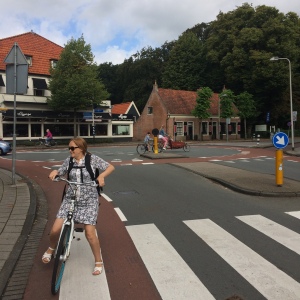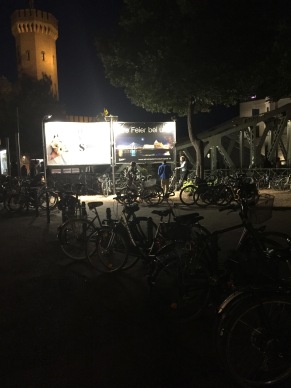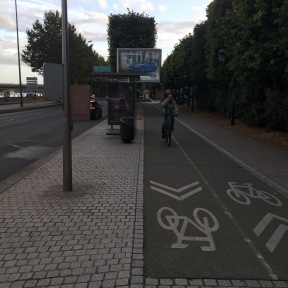
Borneo Sporenburg, Eastern Docklands, Amsterdam.
I was a child of primary school age when I first visited Amsterdam in the early 1980s. It was a family day trip from our campsite near Zeebrugge in Belgium, and despite it being formidably unique amongst cities, I genuinely have no recollection of the place from back then. I went again in the early 2000s and did many of the tourist things – the Anne Frank house, canal cruises, the Heineken Experience and the red light district, (watching, not trading). By then, the character of this place had been inevitably learnt simply because of its place in popular culture, built out of the sea on canals and dominated by folk on foot and on bike. I again can’t recall the first impression I had stepping into this city; life these days is too often seen through second hand sources and the experience of being somewhere for the first time can sometimes seem anticlimactic or diminished.
In 2008, I was lucky enough to lead a trip to Amsterdam for 40 or so built environment professionals (planners, architects, urban designers, highway engineers…) on behalf of the now defunct, and much missed, Commission for Architecture and the Built Environment in 2008. It was part of one of the programmes CABE ran. I had much help from Gerard Maccreanor of respected architects Maccreanor Lavington, who have offices both in The Netherlands and in the UK and who have been instrumental in bringing European thinking to British urban planning. The trip also benefitted from the contribution of Ton Schaap, who was then the Head of Planning for the City of Amsterdam. This was genuinely exciting. I remember that.
By then Amsterdam, and The Netherlands in general, had a solid reputation for forward thinking domestic architecture, equitable and efficient transport systems, innovative business environments, contemporary and attractive design and inclusive public realm. Built environment professionals from the UK have looked longingly at this and sought to bring some of that thinking home in an effort to improve planning and architecture here.
It was the perfect place for CABE to visit. We had an overview of Amsterdam’s development and the public sector’s approach to planning (they own most of the land, which helps enormously). We visited new residential developments at GWL-terrain in the west of the city and at the eastern docklands where Borneo Sporenburg and the work of West 8 was a particular highlight; we spent time in Almere, a new settlement to the east of Amsterdam and we also visited Utrecht to see urban extensions there, particularly the approach to integrating cycling and walking into the fabric of an older city.
England is seeing some Dutch influence more and more; already in the architecture – certainly in denser, urban locations and particularly in London – it’s almost endemic. We now have ‘mini-Holland’ in a handful of London boroughs – including Enfield, my own – which aim to elevate cycling as a means of transport whilst easing us away from cars and encouraging local shopping and better public realm.
As a work visit, Amsterdam 2008 was enjoyed by those who attended and it left something of an impression on me. Finding myself back on holiday in The Netherlands with my family in 2016, I was nevertheless ill-prepared for how impressed I’d be with the way in which the Dutch organise their lives and their cities and I began reflecting on the recent – ever more ridiculous – battles had around Enfield’s mini-Holland scheme…
 Debate about cycling and its impact on public spaces and high streets has been raging in Enfield since the council landed £30m to implement a ‘mini-holland‘ highway scheme a couple of years ago. Whilst the arguments started as level headed and informative, not least because of the Council’s inclusive approach to engagement, it soon became polarised between a small group of vocal, but stubborn, local businesses and petrol heads who seem to think that the only way to access a shop is by parking right outside it and driving your purchases home and a cycle lobby who, whilst at least based in reality, was often an impenetrable mass of statistics and percentages. OK, perhaps I exaggerate for comic effect, but the caricatures are familiar. I had become disenchanted and divorced from the debate, despite the hearty efforts of some good friends who have absolutely embraced a life based on self propelled transport without cause to wearing tight fitting shorts and wrap around shades (I salute you guys…you know who you are). I can only feel for those agnostics who wanted to know more but were bombarded by shouty extremists with immovable opinions.
Debate about cycling and its impact on public spaces and high streets has been raging in Enfield since the council landed £30m to implement a ‘mini-holland‘ highway scheme a couple of years ago. Whilst the arguments started as level headed and informative, not least because of the Council’s inclusive approach to engagement, it soon became polarised between a small group of vocal, but stubborn, local businesses and petrol heads who seem to think that the only way to access a shop is by parking right outside it and driving your purchases home and a cycle lobby who, whilst at least based in reality, was often an impenetrable mass of statistics and percentages. OK, perhaps I exaggerate for comic effect, but the caricatures are familiar. I had become disenchanted and divorced from the debate, despite the hearty efforts of some good friends who have absolutely embraced a life based on self propelled transport without cause to wearing tight fitting shorts and wrap around shades (I salute you guys…you know who you are). I can only feel for those agnostics who wanted to know more but were bombarded by shouty extremists with immovable opinions.
My summer holiday in Holland was chosen not because a desire to see the mother of cycling societies at close quarters but because their CentreParcs was cheaper than our CentreParcs and the trip across the Channel offered the potential to see friends and former colleagues in Amsterdam. I did not expect my head to be turned by the majesty of their societal organisation and the central and essential place that cycling plays in that, but the spectacular success of it meant that my head inevitably was.
Before I endeavour to describe this, let me make one thing clear. Central Amsterdam – those tourist bits you might have seen – is not the best example of cycling and cycling infrastructure and its positive impact on society. Amsterdam is certainly dominated by bikes – the many enormous and bewilderingly crammed multi-storey parking areas outside central station will tell you that. But the centre is a muddled mass of trams, buses, backpackers, tourists, sightseers, residents, employees, smells, sights. The cycling infrastructure is muddled and seemingly incomprehensible. The real magic happens in the small cities and the suburbs – Leiden, Aalkmaar, Haarlem, Schiedam, Zaanstad. Places akin to suburban London; places akin, my friends, to Enfield.
Our first experiences were in Schiedam, a small city on the western side of Rotterdam, famous for having the world’s tallest traditional windmills, six beauties hugging the canal around the northern edge of the centre. Our hotel was in Nieuw Schiedam away from the historic core. Late arriving at our hotel, we drove the couple of miles to the centre. The trip was eventful.

Priority for bikes at roundabouts, Haarlem
The roads were clear and well signed. Every road into the centre was lined with a segregated cycle lane, which were often busier than the roads. We had to negotiate a left turn off the main road, and were immediately struck by the road markings, which gave cyclists priority at the roundabout. As a driver, I became much more cautious. The road after the roundabout – still a key road around the city centre – was a narrow sinuous carriageway for the car, almost residential in nature – bounded by wide green segregated cycle lanes and footpaths. Again cyclists had priority across the road, something I would never forget after almost coming to blows with a cyclist crossing in front of me who made no effort to slow down. It was immediately obvious that all across The Netherlands, cycles are king and the people are his loyal servants.

At pinch points, the space for cars narrows, the space for bikes stays the same (Haarlem)
British people think nothing of going to CentreParcs and willingly giving up their cars, thriving on the excitement of getting between places without risks from other traffic, enjoying dedicated and attractive cycle routes and reaping the physical and spiritual health benefits of powering oneself around. It becomes obvious, second nature. We were no different at our resort in Zandvoort on the west coast, though Dutch parks are smaller, and you’re not so much cycling round the park as cycling round the area, which is easy because most of Holland is not unlike an enormous CentreParcs, in as much as cycling is obvious and becomes second nature.
My wife, our 7 year old daughter, 4 year old son and I took two cycle jaunts, one 4km north towards Overveen and one 9km east to Haarlem. The first was exclusively along dedicated cycle paths alongside each side of the road, at times also alongside segregated bus lanes. The condition of the paths is excellent, they have dedicated sign posts and of course they are busier than the road.

Floating bus stops…the horror. But people get used to them in about 3 minutes (Zandvoort)
The trip to Haarlem took in dedicated cycle lanes alongside the roads through coastal Zandvoort, a section of cycle lane through the national park which brought us out on more dedicated cycle paths alongside the roads from the edge of Haarlem to the city’s glorious centre. Here we experienced our first roundabout as cyclists with absolute priority over any other form of transport, and the Dutch propensity to narrow the carriageway for cars down to a single width rather than compromise the width of the cycle space on both sides of the road where the urban form is restricted. Cars just have to sit and wait, such is the Dutch way.
We’d decided to visit Haarlem on our bikes because we’d visited a day or two earlier by train and been impressed by the historic market square and cathedral, the beautiful streets and canals, the busy bars and cafes – many facing the market square – and the prosperous looking shops, boutiques and market that filled every central traffic free street. The station, 500m or so north of the market square, spills out onto a pedestrianised square and tidy bus interchange, leading the eye to the main street to the centre. This street is a simple road of two car width, but half of that width is dedicated to bikes and the other half barely sees a vehicle. As well as the large areas of parked bikes all along this road and the bikes zipping up and down the road in and out of town, something else strikes the British senses about Haarlem; it is peaceful and the air is clean and fresh. There are no noxious fumes, there is no standing traffic and what one hears is the chatter of people.

The front of Haarlem station. The main road to the centre is in the foreground, dominated by cyclists and pedestrians
I think the ease of movement and the quality of the environment created by limiting car use encourages the town centres to be successful. I don’t think that environmental quality is necessarily connected to architectural quality either. In picking up fresh veg and fruit for our self catering week in Zandvoort, we dropped into a neighbourhood centre in suburban Leiden which we knew hosted two supermarkets; Lidl and Holland’s own Alfred Heijn. The centre was an unspectacular 1970s precinct not unfamiliar to those brought up in post war suburban Britain in the 1960s and 70s – low rise, flat roofed shops facing an internal pedestrianised street. In Britain, it would have been a setting for post-apocalyptic zombie flick, a struggling and stale relic of world in which the out of town retail and leisure park now rules over the local precinct. But this is Holland, where people shop local, use local facilities, get there – on the whole – on their bikes and as a result have a buzzing local shopping centre fulfilling much of their daily need. Whilst it also had ample, clean, bright, accessible and free underground parking for cars, this was two thirds empty. There was no noticeable vacancy amongst the 30 or so shops and during my whole stay I don’t remember seeing a charity shop or a bookie.
These are not isolated incidents. Aalkmaar in northern Holland is one of the most beautiful, surprising and well preserved cities I’ve ever had the pleasure to visit, and the structural approach to movement and the organisation of traffic and urban form is the same, allowing the experience of the city to be maximised by not flooding it with traffic, fumes, noise and conflict between incompatible forms of transport. We stayed in Hoofddorp for four nights, a modern town just beyond Schipol airport and experienced the same.
It helps that the Dutch are adaptable and practical people, unconcerned by demonstrating status through the size and horsepower of their metal box on wheels (4x4s are exceptionally rare on streets) or, indeed, their bikes. They seem to value community and local roots (one Dutch friend said that a car journey of 45 minutes is thought of as ‘a long way’). How people ever find their bikes is mind-boggling given their similarity – functional, black, often without front brakes and gears, all with a built in key locks on the back wheel. Bikes are also customised in many ways – panniers, crates and boxes are commonplace to carry goods, trailers and carriers are common for kids and two child seats on the front and back of a bike are also regularly seen. No-one is excluded from the cycling way of life and it is the preserve of the everyday person. We saw one bike with a wheelchair on the front and, of course, mobility scooter users benefit by having well maintained, segregated and direct routes that they can also use to get about, making society as a whole more equal and inclusive. No one needs brightly coloured Lycra and an unfaltering awareness of dangers on the road to feel utterly at home pedalling around Holland.
This apparent panacea isn’t without its issues; the main ones seem to be the unfamiliarity that visitors have with their road user hierarchy, particularly in the busier parts of busy cities and the danger posed by allowing motorised scooters to share bike lanes. But, on the whole, the Dutch system is certainly one to be admired and aspired to.
It has not been an overnight job; it’s been 40 or 50 years of societal and cultural change that started with a rise against the growth of car use and their role in deaths on streets. It’s where we are now. But it is now second nature to them, and their lifestyle seems to expect it to continue. Allowing bikes to dominate has not destroyed the vibrancy of their places – it has enhanced them massively, encouraging a better and cleaner environment, providing a crisp and attractive cityscape for business and entrepreneurs and developing a reputation for innovation that encourages people to want to live, work, visit and stay in Holland.

The main road into Haarlem; bikes and cars have the same direct route. Parking is tidy.
One final important point; whilst cycling is at the top of the transport food chain, transport routes largely co-exist. Bike routes are not poor cousins shifted onto back routes or separated networks. It’s easy to see how this would not work, because it undermines the importance of the mode and creates indirect and, if not properly signed, confusing and contrived routes. We tried extensive separated cycle networks in our post war new towns; go and visit Stevenage to see how that worked out and how our urban planning is in love with and encourages the car over all else – and be sickened at the missed opportunity.
So, tired of the stats, the percentages and the uninformed opinions, I’ve seen how cycling practically works in Holland’s major cities, it’s large towns and its suburbs and I’m totally convinced that we have it wrong here; utterly wrong. Mini-Holland is a huge step in the right direction. Enfield must hold its nerve and if we do the rewards for our towns in the next generation are enormous.




 Debate about cycling and its impact on public spaces and high streets has been raging in Enfield since the council landed £30m to implement a ‘
Debate about cycling and its impact on public spaces and high streets has been raging in Enfield since the council landed £30m to implement a ‘











